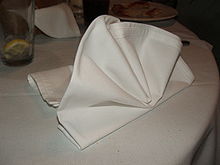- Napkin
-
For other uses, see Napkin (disambiguation).
A napkin, or face towel (also in Canada, the United Kingdom, Australia: serviette) is a rectangle of cloth used at the table for wiping the mouth while eating. It is usually small and folded. The word comes from Middle English, borrowing the French nappe—a cloth covering for a table—and adding -kin, the diminutive suffix.
In the United Kingdom and Canada both terms, serviette and napkin, are used. In the UK, napkins are traditionally U and serviette non-U. In some places, serviettes are those made of paper whereas napkins are made of cloth.[1] The word serviette in lieu of the term napkin is not typically used in American English, though, as discussed is not uncommon in Canadian English and Canadian French. In Australia, 'serviette' generally refers to the paper variety and 'napkin' refers to the cloth variety.
Conventionally, the napkin is often folded and placed to the left of the place setting, outside the outermost fork. In an ambitious restaurant setting or a caterer's hall, it may be folded into more or less elaborate shapes and displayed on the empty plate. A napkin may also be held together in a bundle (with cutlery) by a napkin ring. Alternatively, paper napkins may be contained with a napkin holder.
Napkins were used in ancient Roman times. One of the earliest references to table napkins in English dates to 1384–85.[2]
Summaries of napkin history often say that the ancient Greeks used bread to wipe their hands. This is suggested by a passage in one of Alciphron's letters (3:44), and some remarks by the sausage seller in Aristophanes' play, The Knights.[3] The bread in both texts is referred to as apomagdalia, which simply means bread from inside the crust known as the crumb, and not special "napkin bread".[4]
See also
References
Categories:- Serving and dining
- Linens
- Paper products
Wikimedia Foundation. 2010.

